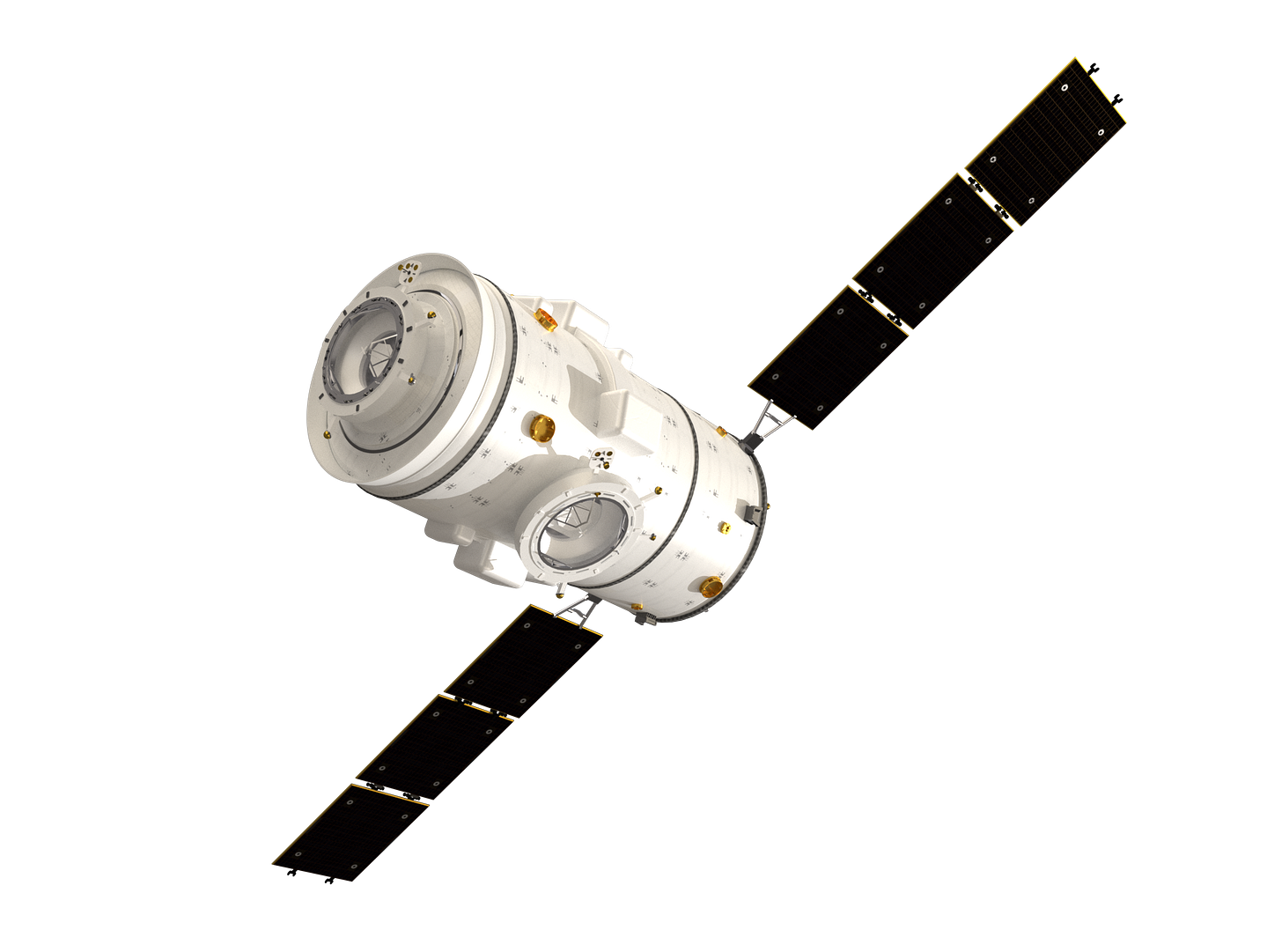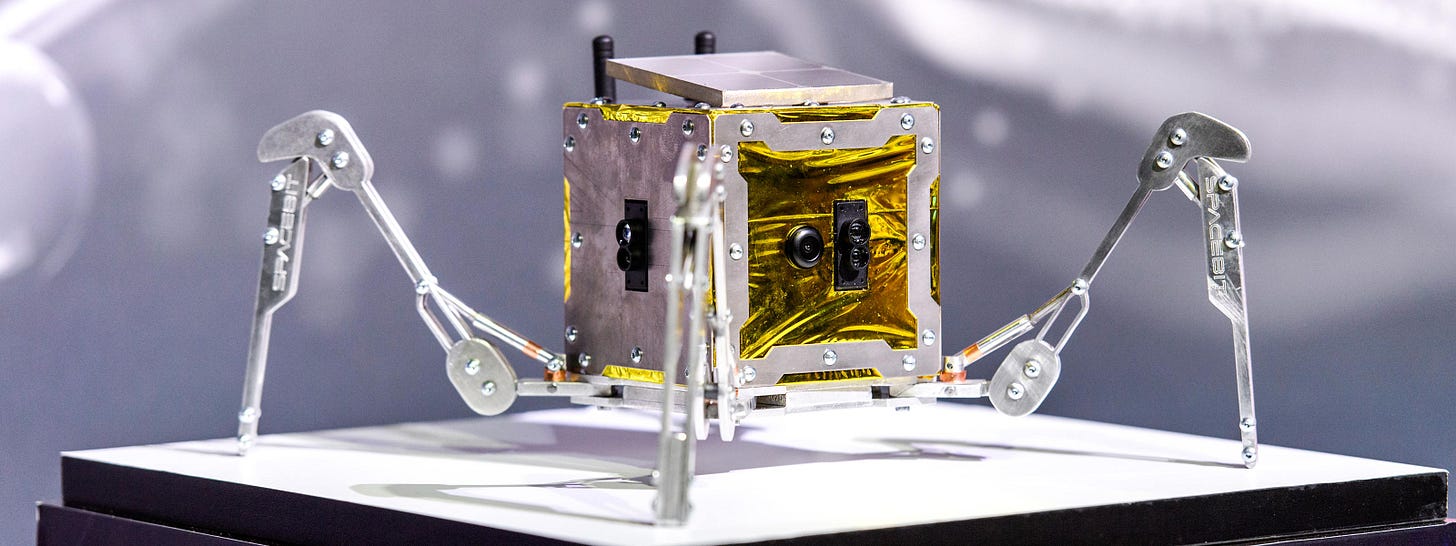Who will build on the Moon?
In this month’s issue:
Building business on the Moon
Who will build on the surface?
Who will build in orbit?
List of 30 planned rovers
Over 100 planned missions
The Moon may get crowded
Other interesting news
(Opinions and analysis are my own)
1. Building business on the Moon
I love seeing people’s eyes light up when I speak about a future where humans and robots work side by side on the Moon, building the infrastructure to advance our species further into the universe. It’s a fantastic prospect that inspires many.
But not everyone is convinced. For some, Moon bases remain trapped in the same mental realm as science fiction. Take, for example, when Mitt Romney challenged former House Speaker Newt Gingrich’s Moon colony proposal during the 2012 presidential debates, saying:
“If I had a business executive come to me and say they wanted to spend a few hundred billion dollars to put a colony on the Moon, I'd say, ‘You're fired.’ The idea that corporate America wants to go off to the Moon and build a colony there, it may be a big idea, but it's not a good idea.”
A former presidential candidate and governor, and now sitting senator, Romney is the former CEO of Bain & Company, one of the “Big Three” management consultancies; the founder of one of the country’s largest private-equity firms; and he graduated in the top 5% of his class at Harvard Business School. Whether or not you agree with his politics, his opinion on business carries weight. And he’s far from alone in this view.
However, I personally feel the tide is beginning to change. For example, this month, the Center for Strategic and International Studies (CSIS) released a report which tallied up 100+ lunar missions over the next 10 years and cited the “economic potential” as a trigger that “drives many companies and countries to pursue lunar and cislunar missions.” Ranked as the #1 think tank in the U.S. and #4 in the world, its reach and influence could garner more serious recognition toward commercial lunar development among business and policy leaders.
Also this month, McKinsey & Co., another one of the “Big Three” management consultancies, published an interview with Joe Landon of Lockheed Martin about the emerging space economy. Landon—also a Harvard Business School MBA—touched on NASA’s efforts to work with industry to build lunar infrastructure and his company’s partnership with General Motors, the largest automaker in the US and one of the largest worldwide, to build a lunar vehicle.
“We may be approaching an age in which companies conduct business in orbit or on the Moon…What the space industry needs is more business talent and more people who understand how to build businesses.”
- Joe Landon, Lockheed Martin
In fact, the largest automaker in the world, Toyota, has also partnered with Japan’s space agency, JAXA, to develop a lunar vehicle. Among many examples of large Japanese companies working on lunar projects, Shimizu and Kajima Corp., two of Japan’s leading construction companies, are studying lunar base development, and this month, the Government of Japan tweeted about the work done by Misawa Homes to test its lunar habitat in Antarctica.
See: Sony, Nissin, Dentsu Urge Japan To Take Moon Business Seriously (Bloomberg)
In 2018, then Secretary of Commerce Wilbur Ross advocated on CNBC to turn the Moon into a “gas station”. The following year, China revealed plans to establish a $10 trillion Earth-Moon economic zone by 2050. In 2020, the first 8 countries signed onto the Artemis Accords; 7 followed in 2021. Last month, The Economist magazine declared that “a new age of lunar exploration is dawning.” And, during a high-level gathering this month, the head of the European Space Agency (ESA) said, “We will use the Moon as an economic zone.”1
With all this momentum, it’s possible that we may soon begin to see a shift in attitude from the broader business sector.
![Space Development Technology Research Method [Antarctica Mobile Station Unit as Research platform] | 历届获奖作品 | Good Design Award Space Development Technology Research Method [Antarctica Mobile Station Unit as Research platform] | 历届获奖作品 | Good Design Award](https://substackcdn.com/image/fetch/$s_!L3pO!,w_1456,c_limit,f_auto,q_auto:good,fl_progressive:steep/https%3A%2F%2Fbucketeer-e05bbc84-baa3-437e-9518-adb32be77984.s3.amazonaws.com%2Fpublic%2Fimages%2F3a5f0e27-4cba-4fbd-ac88-bff6a9a63c87_879x660.jpeg)
2. Who will build on the surface?
NASA announced that it will award up to $200 million to multiple companies to develop new technologies to build up lunar infrastructure, such as “power distribution on the lunar surface, solutions for using lunar resources, or autonomous construction.” This is a continuation of a program in which NASA has provided over $500 million to 50 projects since 2015.2
The agency also awarded $2 million each to 3 universities to develop electronics that can withstand extreme cold, equipment to extract materials suitable for construction, and methods for autonomous landing pad construction.3
Spotlight: Bechtel
The landing pad construction study will be led by the Colorado School of Mines with unspecified contribution from Bechtel, the largest construction company in the US, according to Dr. Paul van Susante of Michigan Tech, who is also involved in the project.
In 2021, a team from NASA and Bechtel, including Bechtel’s CIO, co-authored a paper “to further enable collaboration on a ‘Lunar Mega Project’ to build infrastructure on the Moon… [and to generate] requests for proposals (RFP) by governments to consortiums consisting of construction and space industry companies that will bid on Lunar Infrastructure Projects.”4
With a lack of a local workforce, Bechtel may need to employ robotic labor to build on the Moon. That’s where companies like GITAI come in. This month, GITAI released a video of its “R1” lunar robot that made waves on the internet (its a must watch). The company said R1 verified its ability to drive over rocks and slopes, assemble solar panels, and collect samples.
Related: Last month, ESA ran a successful experiment in which an astronaut on the International Space Station (ISS) in Earth’s orbit controlled a robot avatar on the ground inside a mock lunar landscape in the Netherlands to guide ESA’s robotic lunar exploration efforts.5
3. Who will build in orbit?
With all the robots puttering around on the surface, it will also be necessary to develop infrastructure in the skies above to provide a communications link to Earth. This month, the head of R&D at Argotec, an Italian aerospace company, and a lunar communications expert at NASA’s Jet Propulsion Laboratory penned an article conceptualizing a constellation of 24 lunar satellites placed across 4 orbits to provide near continuous coverage for the whole Moon.
Side note: Argotec is providing 1 of the 10 micro satellites to be launched on NASA’s Artemis 1 mission, which was postponed for late May, at the earliest.

An ESA astronaut tested out a mock-up of the I-HAB, a pressurized habitation module for the Gateway, a planned lunar orbital platform. Led by ESA, the project manager is Franco-Italian aerospace manufacturer, Thales Alenia Space. The module is targeted for deployment in 2026.6
Side note: This month, Thales Alenia Space was awarded 1 million euros from ESA to develop a payload concept to extract oxygen from lunar regolith.7
Also targeting deployment by 2026 (but a bit further out than orbit), a new startup, Quantum Space, led by a former NASA associate administrator Steve Jurczyk, announced plans to construct robotic platforms in cislunar space—specifically in an area known as the L1 Lagrange point—which could provide internet capabilities, collect data, refuel spacecraft, and assemble structures. Jurczyk teamed up with other space industry veterans on this effort, including Kam Ghaffarian, who is also co-founder and executive chairman of the board for the Houston-based lunar lander company Intuitive Machines.8 9 10
4. List of 30 planned rovers
Jatan Mehta, who writes the Our Moon newsletter, provided a great overview of all the rovers being developed for missions planned over the next 5 years, spanning government, commercial, academia, and public-private partnerships.
Here they are in list-form, in the same order as his article:
Dymon’s “Yaoki” (commercial)
Carnegie Mellon University’s “Iris” (academic)
Mexico’s “COLMENA” (academic, government)
JAXA-Sony-Tomy’s “transformable lunar robot” (public-private)
MBRSC’s “Rashid” (government)
MBRSC’s second rover (government)
ispace’s micro-rover (commercial)
ISRO’s Chandrayaan-3 rover (government)
Lunar Outpost MAPP for IM-2 (commercial)
Intuitive Machine’s Micro-Nova (commercial)
NASA’s VIPER (government)
Astrobotic’s CubeRover, formerly MoonRanger (commercial)
JAXA-ISRO’s LUPEX (government-government)
CNSA’s Chang’e-7 rover (government)
Lunar Outpost’s MAPP for Lunar Vertex (commercial)
NASA’s CADRE (government)
Canada’s rover (public-private)
Australia's foundation services rover (public-private)
NASA’s 2025 CLPS rover (government)
NASA’s Lunar Terrain Vehicle (LTV)
Note: You may consider an additional 8 to this list if you account for COLMENA being 5 rovers, NASA sending 4 CADRE rovers, and whether or not GM-Lockheed Martin and Northrop Grumman still make their own LTV even if the other team is selected by NASA.
Credit: Jatan Mehta for compiling
Two more that are missing from Jatan’s list would be:
GITAI’s lunar robotic rover (targeting a tech demo as early as 2025)
Roscosmos’ Luna 28 rover (proposed 2027 - TBC)
And, if we go beyond the 5 year period:
Roscosmos’ Luna 29 rover (proposed 2028 - TBC)
Turkey’s rover (targeting 2028 or 2029)
JAXA-Toyota’s “Lunar Cruiser”(targeting 2029)
KARI’s rover (originally targeting 2025, but now 2030 - TBC)
JAXA-Nissan’s rover (date unspecified)
Honda’s remotely-controlled robot (date unspecified)
Keep in mind, these all have the possibility to be postponed or cancelled.
Canadian Space Agency (CSA) gave an additional $270,000 Canadian dollars (on top of a $1.6 million contract) to Ontario-based Canadensys, one of two companies proposing rover designs to CSA, as well as authorization to start planning for payload integration. Among an assemblage of collaborators, Finnish telecoms firm Nokia is playing an unspecified role in the rover mission.11
Spotlight: Nokia
In 2020, NASA awarded Nokia with $14.1 million to deploy the first LTE/4G communications system on the Moon. Nokia plans to deliver the equipment to the Moon on Intuitive Machines lander. After landing, a rover will deploy from the lander and test Nokia’s wireless network at various distances.12 13 14
Previously, Nokia was selected by British telecoms firm Vodafone for a demo mission to establish a 4G network on the Moon as part of a planned 2019 mission by German lunar lander company Planetary Transportation Systems (formerly PTScientists), but the mission never got off the ground.
5. Over 100 planned missions
The Center for Strategic and International Studies (CSIS), published a report titled, Fly Me to the Moon: Worldwide Cislunar and Lunar Missions, authored by Kaitlyn Johnson, which is an excellent in-depth overview of the plethora of lunar missions planned for the coming decade.
Some key stats from the report:
106 lunar missions planned over the next 10 years
24 commercial missions (of the 106 total)
13 missions searching for water and ice*
19 countries mentioned in the report, including: United States, China, Russia, France, Germany, Italy, Luxembourg, Ukraine, Japan, India, United Kingdom, South Korea, Canada, Australia, United Arab Emirates, Israel, Mexico, Thailand, and Turkey
In contrast to the 106 figure, calculations done in 2020 by Euroconsult and Bryce Space & Technology counted 51 and 95 missions by 2030, respectively.15 16 It’s not clear how the 106 number was determined, but as I’ve said before, it’s difficult to offer precise numbers with information often being presented in a nebulous manner, and, as Johnson wrote, “a lunar lander mission may also have a rover onboard or a secondary payload,” leaving it open to interpretation. So, on the more conservative end, we might be looking at around 5 per year, and on the more ambitious end, around 10 per year with 8 years remaining in the decade and only 1 mission down so far (China’s Chang’e 5).
Note: The report counted only 15 rovers for the next decade—half as much as listed in the section above. The author may have missed some, folded them into different mission types, and/or chose to interpret them differently (i.e., excluding hoppers, large vehicles, early concepts, etc.).
——
*The text in the report mentions 12 but displays 13 in a table.
6. The Moon may get crowded
During a panel hosted by the Federal Aviation Administration, a SpaceX director teased the idea of habitats being integrated to its Starship to create an “incredible Moon base…staffed by hundreds or thousands of scientists and explorers.”
But the surface isn’t the only place that may get crowded. Currently, dozens of payloads and probably fewer than 200 large pieces of space junk orbit the Moon. However, with 50-100 missions planned in the next decade, every launch brings more space debris. For example, on March 4, a rogue rocket stage is expected to smash into the lunar surface. It is likely to have originated from China’s 2014 lunar mission, despite a denial from the country’s Ministry of Foreign Affairs.17 18
“The upcoming lunar impact illustrates well the need for a comprehensive regulatory regime in space, not only for the economically crucial orbits around Earth but also applying to the Moon.”
- Holger Krag, Head of ESA’s Space Safety Programme
As seen in table from the CSIS report, space domain awareness (SDA) accounts for the least amount of mission objectives—at only 3. SDA includes the tracking of artificial objects in cislunar space to prevent collisions, among other things.
The U.S. Space Force aims to have a cislunar domain awareness capability within the next 5-10 years. As such, the U.S. Air Force Research Laboratory (AFRL) has several planned missions to send satellites into cislunar space. This month, the AFRL awarded the Univ. of Arizona $7.5 million to develop ways to manage congestion in cislunar space., and next month, a solicitation is expected for the Cislunar Highway Patrol System (CHPS), which is intended to help the U.S. military observe and track objects in cislunar space.19 20 21 22
“We had a plan to get after cislunar space domain awareness, but now we need to accelerate our plan because things are happening much faster than we expected.”
- Chief of Space Operations Gen. John Raymond
7. Other interesting news (from February 2022)
An online marketplace for lunar payloads: A start-up called Copernic Space launched an online platform, which, as SpaceNews described, aims to “streamline the process of buying and selling space-related products and services” such as payload space. Their first auction is for payload space on Lunar Outpost’s MAPP rover. The purchase includes a non-fungible token (NFT) that can be fractionalized and resold on a secondary public market. Notably, the company’s advisory board includes Kevin O'Connell, former space director at the U.S. Dept. of Commerce.
Note: Lunar Outpost’s MAPP rover is carrying Nokia’s LTE 4G technology demonstration mentioned in a section above.
Eating hummus on the Moon: As I covered in a previous newsletter, Strauss Group, the Israeli company that makes Sabra hummus, funded an experiment led by former SpaceIL co-founder, Yonatan Winetraub, to grow chickpea seeds on the ISS as a precursor for growing crops on the Moon. This month, the team launched 28 seeds to the ISS and, according to some reports, will wait Israeli private astronaut Eytan Stibbe’s arrival, as part of Axiom Mission 1 launching March 30, before the test begins.23 However, The National reported most of the seeds already successfully germinated. Apparently, Israeli agritech firm Haifa Group and American-Irish medical device company Medtronic were also involved in the project.24 25
Note: Stibbe will also wear the AstroRad vest, mentioned in my previous newsletter linked above, to test its comfort and range of motion and provide feedback to the Israeli company who is producing it in aims to support the Artemis program.
Mining companies dig in: Rio Tinto, the world's 2nd largest mining company, and Australian mining company South32 both joined AROSE, a consortium which is conducting a feasibility study for a lunar construction rover for the Australian Space Agency, among other space-related projects. Though neither company specified if they will work on lunar projects, Rio Tinto’s chief scientist said they’re “looking forward to contributing to the programmes supported by AROSE,” particularly in the application of robotics, automation and remote operations.26 27
PHOTO OF THE MONTH

Correction to January’s newsletter, “Your Guide to the Moon in 2022”:
I mistakenly reported that India’s Chandrayaan-3 was delayed until mid-2023. In fact, that mission is currently planned for August 2022.
Disclaimer
The author of this newsletter is employed by ispace, inc. However, this is a private activity and all opinions and analysis are my own. The view expressed should in no way be taken to reflect the official opinion of ispace. This report does not constitute a sales offer and in no event shall it be liable for any investment decision based on the information included in this report. I cannot guarantee that the information included is accurate or complete. Please read the full ‘Disclaimer’ in the ‘About’ section.
In space race, Europe faces choice: passenger or pilot; France24, Feb 1 2022.
NASA Offers Up to $200 Million to Help Push New Technologies to Market; NASA, Feb 15 2022.
NASA Selects Three US Universities to Develop Lunar Infrastructure Tech; NASA, Feb 19 2022.
Lunar Mega Project: Processes, Work Flow, and Terminology of the Terrestrial Construction Industry versus the Space Industry; American Society of Civil Engineers, Apr 15 2021.
Getting ready for lunar orbit; ESA, Feb 18 2022.
THALES ALENIA SPACE WINS STUDY CONTRACT TO DEVELOP PAYLOAD TO EXTRACT OXYGEN ON THE MOON; Thales Group, Feb 22 2022.
Quantum Space poised to enable the cis-lunar space economy; Quantum Space, Feb 3 2022.
Quantum Space unveils plans for cislunar platforms; SpaceNews, Feb 3 2022.
New company run by former NASA leader aims to build robotic outpost near the Moon; The Verge, Feb 3 2022.
Hello, Moon? It’s NASA Calling; NASA, Oct 22 2020.
Nokia selected by NASA to build first ever cellular network on the Moon; Nokia, Oct 19 2020.
Got any signal up here? Nokia to build mobile network on the moon; Reuters, Oct 19 2020.
The 2020s: The space exploration decade with $260 billion invested by governments; Euroconsult, Apr 14 2020.
Projected Exploration Missions (2020-2030); Bryce Space & Technology, Sept 2 2020. Revised Sept 8 2020.
China casts doubt on origin of rocket debris about to slam into the Moon; The Verge, Feb 22 2022.
Moon-bound rocket stage still most likely from 2014 Chang’e mission, despite China’s denial; SpaceNews, Feb 23 2022.
Air Force Research Lab building momentum on cislunar projects; C4ISRNet, Feb 14 2022.
$7.5M effort seeks to prevent lunar traffic jams; The University of Arizona, Feb 14 2022.
Air Force paying to prevent 'lunar traffic jams'; The Hill, Feb 16 2022.
The Moon could soon have a space junk problem; Science, Feb 22 2022.
Food giant Strauss Group, Aviv Labs launch hummus-filled capsule to space; CTech, Feb 20 2022.
Israel's 'Space Hummus' experiment launched, headed for ISS; The Jerusalem Post, Feb 20 2022.
28 chickpeas launched to ISS for Israeli-led ‘space hummus’ experiment; The Times of Israel, Feb 20 2022.
Rio joins the space race; Mining Weekly, Feb 14 2022.
South32 joins Australian space consortium; Mining Weekly, Feb 28 2022.








